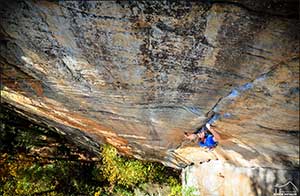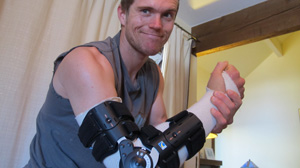
Chris Barlow, a Boulder, Colorado resident and seasoned rock climber, experienced a distal biceps tendon rupture in December of 2012. He underwent bicep tendon repair surgery so he could return to high level climbing.
After his injury Chris was faced with challenges not yet seen before at even the highest peaks. It goes without saying that the sport of rock climbing is not for the faint of heart. High in the air, climbers overcome steep inclines using narrow crevices and tiny edges to advance to the top. The complicated maneuvers can be both stunning to look at, yet physically challenging to master.
Chris measures his climbing success not by how high he can climb, but instead by the difficulty, technical aspects, and the style. In December, Chris and his wife Becca traveled to Spain to climb El Chorro to achieve this goal. This massive piece of limestone erupts from the Andalucian landscape, and every side of it offers unparalleled climbing features. According to Chris, “In sport climbing, it doesn’t get much better than El Chorro.”
The Injury: Distal Biceps Tendon Rupture (Tear)
During their trip, under beautiful skies and perfect weather, Chris had already completed a couple of successful climbs. It was later that day, according to Chris, that “I got greedy.” It was his third day of climbing, and his goal was to climb the Swimming Through a Shark Attack. This rough 8a+ climb resides on the steepest part of the Poema Cave. During this climb, Chris heard a sudden, sharp snap and felt his biceps retract up towards his shoulder. Sharp pain, elbow weakness, and loss of strength were immediate features of the injury. This left Chris with no choice but to let go and lower himself to the ground.
Chris did some research and correctly determined that he had torn his distal biceps tendon. This occurs usually from a single, traumatic event when rapid, unexpected eccentric loads are placed on the flexed elbow. Once back in Boulder, it was confirmed that he had a distal biceps tendon rupture. This meant that the biceps tendon had torn at the elbow and completely pulled away from the bone. Distal biceps tendon ruptures are common among weight lifters and rock climbers. Chris’s distal biceps tendon tear occurred during a difficult climbing move. During this climbing sequence, he was using a lot of force to hold himself up so he could propel himself to his next move. He was now facing he possibility of losing his climbing career.
Undergoing Bicep Tendon Repair Surgery with Dr. Peter Millett
During his quest to find the best treatment for his injury, Chris learned about Dr. Millett, and his successes in repairing other athletes with distal biceps tendon ruptures. “I read that Dr. Millett fixed the distal biceps of Brian Shaw – The World’s Strongest Man, after he had ruptured it lifting a train axel in competition,” said Chris. “It really intrigued me to get in with him. I felt lucky because, his assistant, Susan called me back and was able to fit me in to their busy schedule. We traveled to Vail, and Dr. Millett examined my arm and reviewed the MRI of my distal biceps tendon rupture. Then Dr. Millett laid out the options.”
“My options were to have bicep tendon repair surgery or to let it heal on its own. Not getting surgery would likely lead to a significant loss in arm strength, which in climbing, is essential to successfully ascend difficult climbs.” Without the ability to flex and rotate the elbow, Chris was concerned he wouldn’t be able to climb at a high level again. “Surgery seemed the more prudent approach and was my only answer. Later that afternoon, I was wheeled into the operating room.”
During the operation, Dr. Millett performed a repair of the distal biceps tendon rupture using a single incision approach and cortical button fixation. This is the strongest type of fixation and allows for earlier and more aggressive post-op rehab. In Chris’ case, his biceps tendon was delivered from the upper arm where it had retracted like a torn rubber band and reattached back to the bone.
Right after surgery, Chris immediately started rehab. The goal was to reduce inflammation, restore mobility to his elbow, and to encourage the tissue to heal. During this first appointment, the physical therapist worked to lightly massage his arm and do passive range of motion. When Chris returned to Boulder he continued rehab where he progressively used his arm during active range of motion and strengthening exercises. Dr. Millett also prescribed a brace to be worn outside of rehab in order to protect the repair.
Recovery From Bicep Tendon Repair Surgery
 Chris is more than 10 weeks out from his bicep tendon repair surgery and he is continuing to make great strides in his recovery. According to Chris, “My arm feels great and aside from a scar and some very mild muscle atrophy, it looks normal.”
Chris is more than 10 weeks out from his bicep tendon repair surgery and he is continuing to make great strides in his recovery. According to Chris, “My arm feels great and aside from a scar and some very mild muscle atrophy, it looks normal.”
He continues by saying, “Dr. Millett’s team and my physical therapists were great and are very optimistic that I will begin climbing-specific training next week (week 12 from surgery). They are confident that at three months I will be able to return to climbing at a moderate level. They also say that at four months I am expected to be able to climb at my full level without any restrictions. This news cannot be more welcomed. I have a big climbing trip planned in May (five months from my surgery), and I’ve been told that I should be back to 100%.”
“Words cannot express my thanks to Dr. Millett and his entire team of physician assistants, trainers, PTs and nurses. They fit me in for a consultation and performed my bicep tendon repair the same day. At the same time they made the entire process seamless, comfortable, and reassuring. Dr. Millett clearly understands an athlete’s desire to get back to pre-injury level. He understood the demands that I put on my body in climbing and addressed my expectations for performance after recovery. I am very grateful that I had such an outstanding team behind me every step of the way.”
To read more about Chris Barlow and his rock climbing adventures, visit his blog: http://roconista.wordpress.com/

